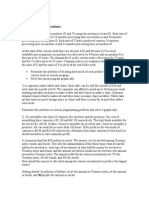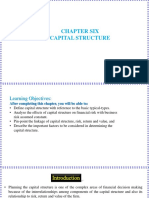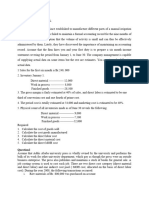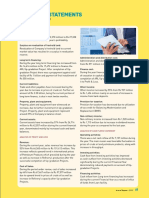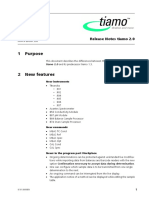Revolution in Egypt Case Study
Revolution in Egypt Case Study
Uploaded by
John PickleCopyright:
Available Formats
Revolution in Egypt Case Study
Revolution in Egypt Case Study
Uploaded by
John PickleOriginal Description:
Copyright
Available Formats
Share this document
Did you find this document useful?
Is this content inappropriate?
Copyright:
Available Formats
Revolution in Egypt Case Study
Revolution in Egypt Case Study
Uploaded by
John PickleCopyright:
Available Formats
Revolution in Egypt Case Study
1. What were the underlying causes, economic and political, of the collapse of the Mubarak
regime?
1. Inflation was at a high rate of 12.8% and superficial reforms are falling apart. A
global economic crisis decreased tourism ( accounted for 8.5% of GDP), and there
was a huge socioeconomic gap between the rich and the poor. Around 2.8 million
people could not afford their basic food necessities. Foreign governments were
pressuring Mubarak to step down and to transition to a democratic election
because of the corruption in the government.
2. What do you think the Egyptian government needs to do in order to get the economy
growing again and to attract foreign capital? What are the risks to the government of
taking such actions?
1. The government needs to take a more democratic approach to reforms and
policies. There could also be investments in infrastructure to create more jobs and
a safer environment. Political stability can positively affect the economy.
Investors would increase their business in Egypt and tourism would also increase.
The government could face retaliation from the former way of a corrupted
government and it may take time to implement a cash-flow economy.
3. What dangers do you see in the current trajectory of the Egyptian economy? What are the
implications of these dangers for foreign companies that might consider doing business in
Egypt? What do you think it would take to encourage more foreigners to visit, invest, and
do business in Egypt? Would such inward investment be good for the Egyptian
economy?
1. Since Egypt is straying away from democratic leadership, investors and
companies may not be willing to risk an investment where there is no democratic
leadership and the government owns many of he companies and businesses. The
current state of the economy could be changed and create jobs for citizens. If the
government turns to democracy, investors will be more satisfied with the
economic and political forces.
2. The biggest thing Egypt needs to do is get a stable economy and a democratic
government. Potential investors may not be promoted to invest in a country that
has a corrupted government or if there are high amounts of violence occurring. An
inward investment into the stability of the economy would be good because
companies would look for investment opportunities and tourism would increase.
More jobs would be made and people would have more money to spend.
4. Political risks in Egypt seem to be increasing again, and the country seems to be
retreating from democracy, largely due to intervention by the military. As a manager in
an international business, how would the current turmoil and political uncertainty in
Egypt influence your investment decisions, and what does this mean for the future of the
Egyptian economy?
1. Political risk in Egypt seems to be high as the current economic state doesn’t
seem to be too attractive to investors. Not having new investors, and if current
investors pull out, Egypt’s economy will face additional problems.
You might also like
- Apple Case StudyDocument2 pagesApple Case StudyJohn Pickle100% (2)
- Apple's FdiDocument2 pagesApple's FdiezralhakimiNo ratings yet
- I. Industry Background: A. Brief History B. Current Environment C. Transformations D. Future ScopeDocument12 pagesI. Industry Background: A. Brief History B. Current Environment C. Transformations D. Future ScopeĐức Tùng100% (1)
- PQR Limited Is An Engineering Company Engaged in The ManufactureDocument2 pagesPQR Limited Is An Engineering Company Engaged in The ManufactureAmit PandeyNo ratings yet
- Reliable Electric Is Considering A Proposal To Manufacture A NewDocument2 pagesReliable Electric Is Considering A Proposal To Manufacture A Newtrilocksp Singh0% (1)
- The Balance of PaymentsDocument6 pagesThe Balance of PaymentsSOURAV MONDALNo ratings yet
- Introduction To Managerial Finance: 1) Essay QuestionsDocument22 pagesIntroduction To Managerial Finance: 1) Essay QuestionsMohamed Diab100% (1)
- Break-Even AnalysisDocument1 pageBreak-Even AnalysisJohn PickleNo ratings yet
- Airline Simulation SWOTDocument1 pageAirline Simulation SWOTJohn PickleNo ratings yet
- Intelligen SuperPro Designer v9.0 Build 2 InstallDocument1 pageIntelligen SuperPro Designer v9.0 Build 2 Installnitanita7No ratings yet
- Mixi - Facebook Case AnalysisDocument11 pagesMixi - Facebook Case AnalysisAbriel Bumatay100% (1)
- Case 15 Savola GroupDocument21 pagesCase 15 Savola GroupYassine FalkNo ratings yet
- Topic 3 4 5 6 7 Cash Flow Analysis CFO CFI CFFDocument22 pagesTopic 3 4 5 6 7 Cash Flow Analysis CFO CFI CFFYadu Priya DeviNo ratings yet
- Where Financial Reporting Still Falls ShortDocument8 pagesWhere Financial Reporting Still Falls ShortRavikanth ReddyNo ratings yet
- Huc Acc201-Revision Questions May Intake, 2022Document29 pagesHuc Acc201-Revision Questions May Intake, 2022Sritel Boutique HotelNo ratings yet
- Pso Internship ReportDocument33 pagesPso Internship ReportArslan ShakirNo ratings yet
- Linear Programming ExamplesDocument7 pagesLinear Programming ExamplesgoforjessicaNo ratings yet
- BCG MatrixDocument17 pagesBCG MatrixGowri J BabuNo ratings yet
- Financial Management IDocument58 pagesFinancial Management Igelango124419No ratings yet
- CH 20Document14 pagesCH 20KARISHMAATA2No ratings yet
- Chapter 1 - The Changing Face of BusinessDocument6 pagesChapter 1 - The Changing Face of BusinessArsalNo ratings yet
- AS Economics Cheat Sheet - PDF (FINAL)Document19 pagesAS Economics Cheat Sheet - PDF (FINAL)Shanzay FatimaNo ratings yet
- Chapter 6 Capital Structure PDFDocument20 pagesChapter 6 Capital Structure PDFmuluken walelgnNo ratings yet
- Factors Affecting International Business Environment PDFDocument2 pagesFactors Affecting International Business Environment PDFDaniel100% (2)
- Assignment 03 - Conduct A Comprehensive AnalysisDocument7 pagesAssignment 03 - Conduct A Comprehensive Analysisriham abdelsalamNo ratings yet
- AFM Lecture 11Document24 pagesAFM Lecture 11Alseraj TechnologyNo ratings yet
- Presentation o Management Strategy and Strategic Planning of Singer BangladeshDocument11 pagesPresentation o Management Strategy and Strategic Planning of Singer BangladeshAshiqur RahmanNo ratings yet
- PPTDocument3 pagesPPTKunal TibrewalNo ratings yet
- India Petroleum Industry Case StudyDocument5 pagesIndia Petroleum Industry Case Studynedcisa114No ratings yet
- Capital Structure, Cost of Capital and ValueDocument33 pagesCapital Structure, Cost of Capital and Valuemanish9890No ratings yet
- Chapter 3 Focusing Marketing Strategy With Segmentation and Positioning When You Finish This Chapter You ShouldDocument30 pagesChapter 3 Focusing Marketing Strategy With Segmentation and Positioning When You Finish This Chapter You ShouldMinalNo ratings yet
- Problems: Linear Programming Modeling Applications: With Computer Analyses in ExcelDocument3 pagesProblems: Linear Programming Modeling Applications: With Computer Analyses in ExcelMara Alyssa Cunanan DalisayNo ratings yet
- Bbmf3123 International Finance: Mds-Wealth-Shrinks-Over-Rm1b-Paper-After-Audit-IssuesDocument8 pagesBbmf3123 International Finance: Mds-Wealth-Shrinks-Over-Rm1b-Paper-After-Audit-IssuesSharon ChinNo ratings yet
- ESS and Hotel IndustryDocument20 pagesESS and Hotel Industryparul198731100% (1)
- Project Financial Appraisal - NumericalsDocument5 pagesProject Financial Appraisal - NumericalsAbhishek KarekarNo ratings yet
- OB, Session 1Document30 pagesOB, Session 1kristokunsNo ratings yet
- Competitor AnalysisDocument14 pagesCompetitor AnalysisRicha SharmaNo ratings yet
- Appendix GDocument3 pagesAppendix GYardie TreyBwoy100% (1)
- LPPDocument3 pagesLPPkisna1209No ratings yet
- Harshad Mehta and Ketan Parikh ScamDocument6 pagesHarshad Mehta and Ketan Parikh ScamAnkur MadaanNo ratings yet
- ForecastingDocument87 pagesForecastingaman prajapatiNo ratings yet
- Operations and Supply Chain Management Week 2Document5 pagesOperations and Supply Chain Management Week 2Rhyn RutherfordNo ratings yet
- The Effectiveness of Training Program in The Case of Ethio-TelecomDocument98 pagesThe Effectiveness of Training Program in The Case of Ethio-Telecomnati100% (1)
- P2 November 2014 Question Paper PDFDocument20 pagesP2 November 2014 Question Paper PDFAnu MauryaNo ratings yet
- Cost AssignmentDocument4 pagesCost Assignmentnewaybeyene50% (1)
- Fintech About The Course & SyllabusDocument6 pagesFintech About The Course & SyllabusVanyaa Kansal100% (1)
- Olive Oil World Market Dynamics and Policy ReformsDocument15 pagesOlive Oil World Market Dynamics and Policy ReformslortizudecNo ratings yet
- HRM Assignment 2Document6 pagesHRM Assignment 2Rachel Rego100% (1)
- Ie426 HW5Document2 pagesIe426 HW5fulmanti deviNo ratings yet
- 4, Understanding Market OpportunitiesDocument24 pages4, Understanding Market OpportunitiesumairNo ratings yet
- IS Concept 2020 - Session 17 - Social Computing (T)Document27 pagesIS Concept 2020 - Session 17 - Social Computing (T)Derian WijayaNo ratings yet
- Chapter 8 Government Intervention in International BusinessDocument6 pagesChapter 8 Government Intervention in International BusinessdivyaNo ratings yet
- Financial Statements: Analysis of Attock Refinery LimitedDocument1 pageFinancial Statements: Analysis of Attock Refinery LimitedHasnain KharNo ratings yet
- IplDocument13 pagesIplintisarNo ratings yet
- Assignment IDocument2 pagesAssignment Ijust loughNo ratings yet
- Income Tax Guide UgandaDocument13 pagesIncome Tax Guide UgandaMoses LubangakeneNo ratings yet
- Mavis Machine ShopDocument1 pageMavis Machine ShopSoni KavithaNo ratings yet
- Unit 3 International BusinessDocument25 pagesUnit 3 International BusinessMrudul MuraliNo ratings yet
- 1.1. Introduction To Macroeconomics: Chapter OneDocument118 pages1.1. Introduction To Macroeconomics: Chapter OneBereketNo ratings yet
- Capital StructureDocument22 pagesCapital Structurevenance62No ratings yet
- Motuma SintayehuDocument87 pagesMotuma SintayehuBekele Guta GemeneNo ratings yet
- Portfolio Theory 2Document65 pagesPortfolio Theory 2Kevin NamiNo ratings yet
- The Future of Work: Adapting to the Rise of Automation and AIFrom EverandThe Future of Work: Adapting to the Rise of Automation and AINo ratings yet
- The Economics of Egypt's Rising Authoritarian OrderDocument26 pagesThe Economics of Egypt's Rising Authoritarian OrderCarnegie Endowment for International PeaceNo ratings yet
- Chapter 33 AnswersDocument10 pagesChapter 33 AnswersJohn PickleNo ratings yet
- Chapter 8 ACCT 1Document56 pagesChapter 8 ACCT 1John PickleNo ratings yet
- Appendix 11ABDocument4 pagesAppendix 11ABJohn PickleNo ratings yet
- Test #4 Part CDocument1 pageTest #4 Part CJohn PickleNo ratings yet
- Test #5 Part CDocument2 pagesTest #5 Part CJohn PickleNo ratings yet
- Ghana Case StudyDocument2 pagesGhana Case StudyJohn PickleNo ratings yet
- Chapter 5 Case StudyDocument1 pageChapter 5 Case StudyJohn PickleNo ratings yet
- Ipsos 2022 FIFA World Cup Global Advisor Survey Report - Public VersionDocument23 pagesIpsos 2022 FIFA World Cup Global Advisor Survey Report - Public VersionAris DarussalamNo ratings yet
- 4374-Article Text-11510-1-10-20231007Document19 pages4374-Article Text-11510-1-10-20231007guwenalesaNo ratings yet
- Mobile Marketing Channel Online Consumer Behavior: Mahmud Akhter Shareef Yogesh K. Dwivedi Vinod KumarDocument150 pagesMobile Marketing Channel Online Consumer Behavior: Mahmud Akhter Shareef Yogesh K. Dwivedi Vinod KumarLenard GarxiaNo ratings yet
- F2F Applied Business Tools HM 213 Brandon Rey Arante First Semester 2021Document12 pagesF2F Applied Business Tools HM 213 Brandon Rey Arante First Semester 2021Crizz Oracion MedijaNo ratings yet
- 2011 California Rules of Court Summery JudgmentDocument6 pages2011 California Rules of Court Summery JudgmentdsnetworkNo ratings yet
- Neuspell: A Neural Spelling Correction ToolkitDocument7 pagesNeuspell: A Neural Spelling Correction ToolkitdzakybdNo ratings yet
- PileBuck 2013v29i4Document56 pagesPileBuck 2013v29i4bobbyccw100% (1)
- Tiamo Release Notes 2.0Document5 pagesTiamo Release Notes 2.0KrishnaNo ratings yet
- Revv-Generator-120-MKII-Manual-2019Document43 pagesRevv-Generator-120-MKII-Manual-2019xavierNo ratings yet
- JU Masters in Environmental Science & Management (2020)Document3 pagesJU Masters in Environmental Science & Management (2020)Md. Aminur Rahman100% (1)
- Letter and Letter 555Document2 pagesLetter and Letter 555Ruchi Jain100% (1)
- Module 8-9 Big Data and E-ScienceDocument4 pagesModule 8-9 Big Data and E-ScienceLive LoveNo ratings yet
- CH 07Document25 pagesCH 07Lim Soong XIanNo ratings yet
- Short MODU Specs of Cuu LongDocument2 pagesShort MODU Specs of Cuu LongThem Bui XuanNo ratings yet
- Online Chess MagazinesDocument7 pagesOnline Chess MagazinesKartik ShroffNo ratings yet
- Complete BS BBA Four Years Program Syllabus For AC Pages 23 35Document13 pagesComplete BS BBA Four Years Program Syllabus For AC Pages 23 35Alizeh KazmiNo ratings yet
- Submitted To: Sir Jawad Abdul Ghaffar Submitted By: Muhammad ZaheerDocument36 pagesSubmitted To: Sir Jawad Abdul Ghaffar Submitted By: Muhammad ZaheerAli Abbas HadiNo ratings yet
- ISO 1043 1 2011 PlasticsDocument11 pagesISO 1043 1 2011 PlasticsአንዋርጀማልNo ratings yet
- FR 4Document3 pagesFR 4Amit YadavNo ratings yet
- Association of Mutual Funds in India: Registration Form For CorporateDocument5 pagesAssociation of Mutual Funds in India: Registration Form For CorporateManish SumanNo ratings yet
- Impairment of Assets (IAS 36)Document16 pagesImpairment of Assets (IAS 36)cynthiama7777No ratings yet
- FJ Hydraulic Seals Rod Part (Vedação Haste)Document120 pagesFJ Hydraulic Seals Rod Part (Vedação Haste)SérgioTeixeiraAraújoNo ratings yet
- Hind Adhesives BBG AdjustedDocument2 pagesHind Adhesives BBG Adjustedgraheeth26No ratings yet
- Enterprise ValuationDocument3 pagesEnterprise ValuationParth MalikNo ratings yet
- Rendercv Classic ThemeDocument2 pagesRendercv Classic ThemePatty janeth CcapaNo ratings yet
- Cyber security lab manualDocument28 pagesCyber security lab manualkaushiksandhu115No ratings yet
- 08 Evaluation and Care of A Polytraumatized PatientDocument10 pages08 Evaluation and Care of A Polytraumatized PatientТања ДимитровскаNo ratings yet
- Eps 8089Document24 pagesEps 80891272531185No ratings yet
- AIRs LM Business Finance Q1 MOD 2Document19 pagesAIRs LM Business Finance Q1 MOD 2Oliver N AnchetaNo ratings yet
















